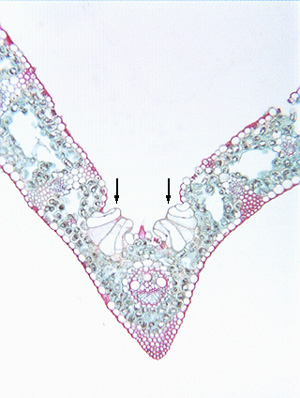 Fig.
10.5-3. Transverse section of grass leaf (Poa
praetense). During drought, many grass leaves close as the two sides of the
blade fold up toward each other. Once adequate water is available, the leaves
open again. When folded, the leaves are less exposed to sunlight, so they are
heated less. This
movement is due to water being absorbed or lost by very large epidermis cells,
called bulliform cells (see pages 194
and 195 in Plant Anatomy [Mauseth]). The bulliform cells (arrows) are
located near the midrib. This species only has the two sets of bulliform cells,
each set running the length of the midrib. In other species of grasses, there
may be many sets of bulliform cells, allowing the leaf blade to curl or roll up
rather than merely fold.
Fig.
10.5-3. Transverse section of grass leaf (Poa
praetense). During drought, many grass leaves close as the two sides of the
blade fold up toward each other. Once adequate water is available, the leaves
open again. When folded, the leaves are less exposed to sunlight, so they are
heated less. This
movement is due to water being absorbed or lost by very large epidermis cells,
called bulliform cells (see pages 194
and 195 in Plant Anatomy [Mauseth]). The bulliform cells (arrows) are
located near the midrib. This species only has the two sets of bulliform cells,
each set running the length of the midrib. In other species of grasses, there
may be many sets of bulliform cells, allowing the leaf blade to curl or roll up
rather than merely fold.